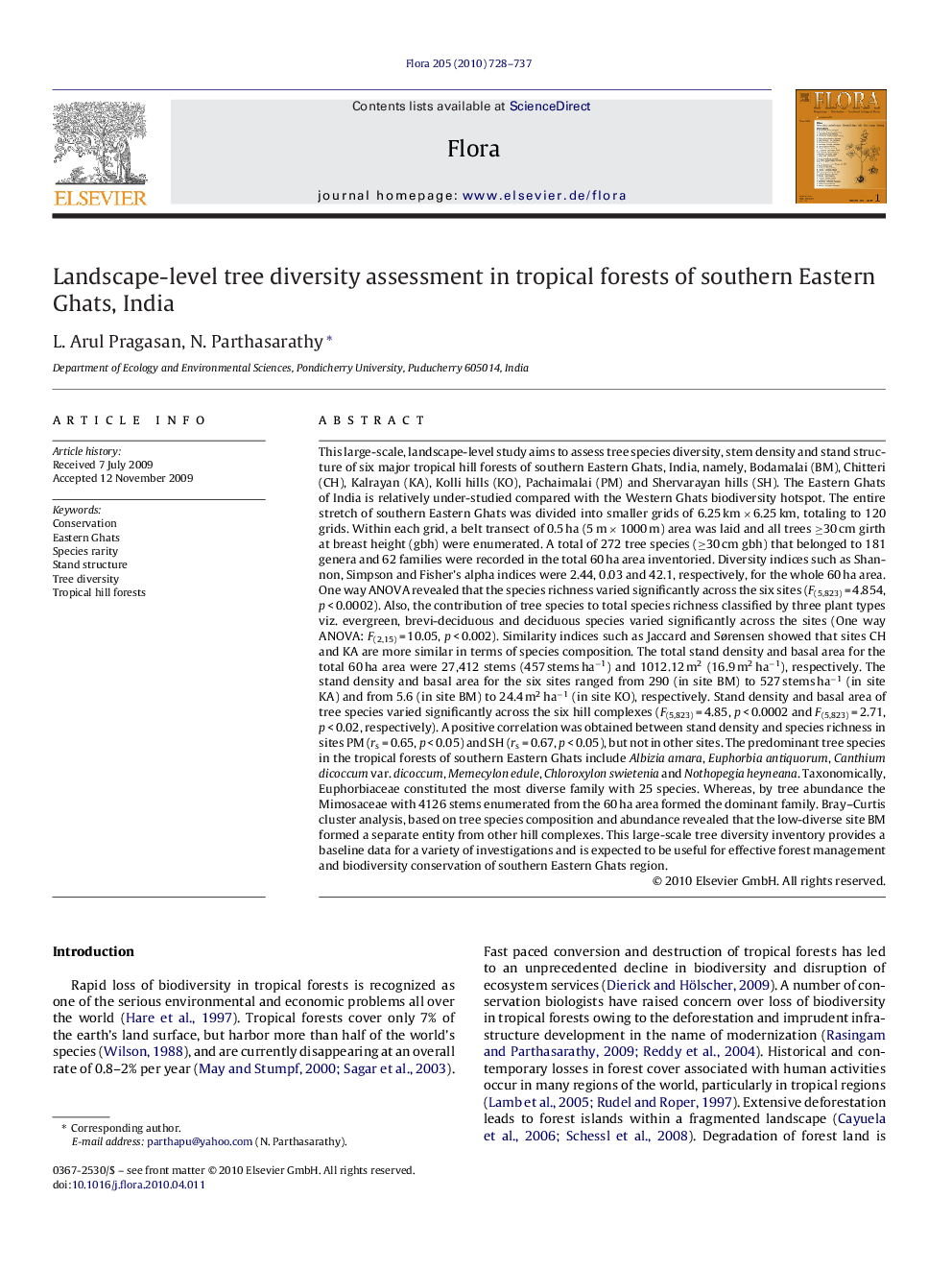| کد مقاله | کد نشریه | سال انتشار | مقاله انگلیسی | نسخه تمام متن |
|---|---|---|---|---|
| 2179944 | 1095096 | 2010 | 10 صفحه PDF | دانلود رایگان |

This large-scale, landscape-level study aims to assess tree species diversity, stem density and stand structure of six major tropical hill forests of southern Eastern Ghats, India, namely, Bodamalai (BM), Chitteri (CH), Kalrayan (KA), Kolli hills (KO), Pachaimalai (PM) and Shervarayan hills (SH). The Eastern Ghats of India is relatively under-studied compared with the Western Ghats biodiversity hotspot. The entire stretch of southern Eastern Ghats was divided into smaller grids of 6.25 km × 6.25 km, totaling to 120 grids. Within each grid, a belt transect of 0.5 ha (5 m × 1000 m) area was laid and all trees ≥30 cm girth at breast height (gbh) were enumerated. A total of 272 tree species (≥30 cm gbh) that belonged to 181 genera and 62 families were recorded in the total 60 ha area inventoried. Diversity indices such as Shannon, Simpson and Fisher's alpha indices were 2.44, 0.03 and 42.1, respectively, for the whole 60 ha area. One way ANOVA revealed that the species richness varied significantly across the six sites (F(5,823) = 4.854, p < 0.0002). Also, the contribution of tree species to total species richness classified by three plant types viz. evergreen, brevi-deciduous and deciduous species varied significantly across the sites (One way ANOVA: F(2,15) = 10.05, p < 0.002). Similarity indices such as Jaccard and Sørensen showed that sites CH and KA are more similar in terms of species composition. The total stand density and basal area for the total 60 ha area were 27,412 stems (457 stems ha−1) and 1012.12 m2 (16.9 m2 ha−1), respectively. The stand density and basal area for the six sites ranged from 290 (in site BM) to 527 stems ha−1 (in site KA) and from 5.6 (in site BM) to 24.4 m2 ha−1 (in site KO), respectively. Stand density and basal area of tree species varied significantly across the six hill complexes (F(5,823) = 4.85, p < 0.0002 and F(5,823) = 2.71, p < 0.02, respectively). A positive correlation was obtained between stand density and species richness in sites PM (rs = 0.65, p < 0.05) and SH (rs = 0.67, p < 0.05), but not in other sites. The predominant tree species in the tropical forests of southern Eastern Ghats include Albizia amara, Euphorbia antiquorum, Canthium dicoccum var. dicoccum, Memecylon edule, Chloroxylon swietenia and Nothopegia heyneana. Taxonomically, Euphorbiaceae constituted the most diverse family with 25 species. Whereas, by tree abundance the Mimosaceae with 4126 stems enumerated from the 60 ha area formed the dominant family. Bray–Curtis cluster analysis, based on tree species composition and abundance revealed that the low-diverse site BM formed a separate entity from other hill complexes. This large-scale tree diversity inventory provides a baseline data for a variety of investigations and is expected to be useful for effective forest management and biodiversity conservation of southern Eastern Ghats region.
Journal: Flora - Morphology, Distribution, Functional Ecology of Plants - Volume 205, Issue 11, November 2010, Pages 728–737